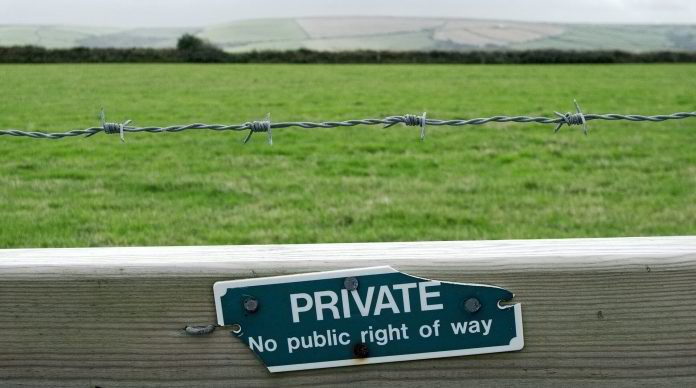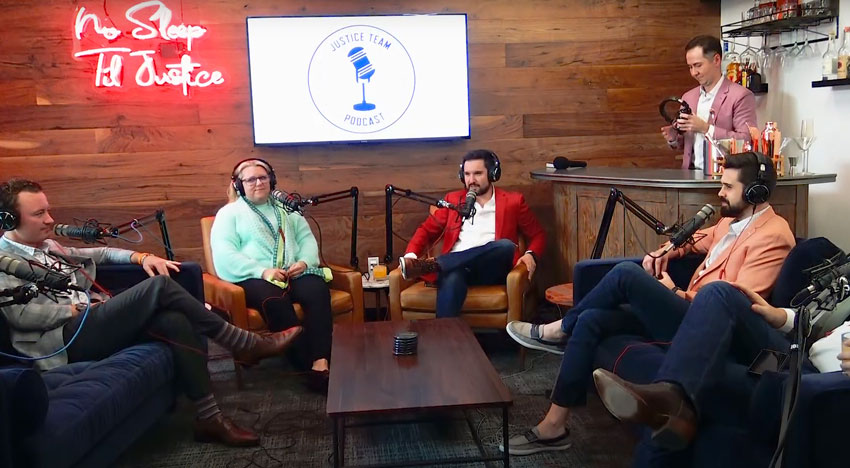The scope of a landowner’s duty of care is rather common-sense in a post-Rowland world. It extends to foreseeable consequences of what a landowner controls. A simplified example is when a landowner’s rotten tree falls from its yard and into the adjacent street injuring a pedestrian riding their bicycle. Naturally, the landowner would be responsible for those injuries. This holds true even if the injury may have occurred on public property).
This simple rule has been contorted by the defense for years, suggesting that where the injury occurred is dispositive. The defense points to the location of injury, the language of CACI Jury Instruction No. 1000, and argues that the landowner’s duty of care does not extend to the public streets. This conclusion, in a vacuum, is generally accurate; however, it fails to properly analyze the negligent behavior that resulted in an injury. Unfortunately, time and time again trial courts accept a defendants’ reasoning, no matter how many flaws there are. Then, there is a reversal on appeal. This “victory” is is not really a victory. It commonly creates a pattern of delayed justice. This severely prejudices the plaintiff who then have to await their day in court.
This article will briefly examine a string of cases spanning the past half-century, which illustrate a landowner’s duty of care for injuries sustained outside their property. These cases will provide support for a successful opposition to demurrer or motion for summary judgment, and, ultimately, end the cycle of prejudice towards plaintiffs. Note: reference to the “single duty rule” is synonymous with the landowner’s duty of care.
General Rule(s)
Everyone is responsible, not only for the result of his or her willful acts, but also for an injury occasioned to another by his or her want of ordinary care or skill in the management of his or her property or person, except so far as the latter has, willfully or by want of ordinary care, brought the injury upon himself or herself. (Code of Civil Procedure § 1714 (a).)
This law has remained unchanged since California adopted the Code of Civil Procedure from New York in 1887. Needless to say, this general principal is, and remains, the law of the land as it pertains to a landowner’s duty of care.
C.C.P. § 1714 (a) was thrust back into the limelight by Rowland v. Christian (1968)1. Rowland simplified the scope of a landowner’s duty of care for injuries sustained on their property. Specifically, pre-Rowland (a quick refresher for anyone’s upcoming Bar exam) proposed an entrant classification system: invitee, licensee and trespasser. This classification system, unfortunately, led to more questions than answers given that each label carried a differing duty of care. After years of differing judicial opinions of the precise scope and meaning of these labels, Rowland reaffirmed the principal set forth in C.C.P. § 1714 (a). Meaning, “everyone is responsible” for the natural consequences of their actions, landowner or otherwise.2
Rowland’s holding, however, was limited towards a landowner’s duty of care for injuries sustained within their property, and arguably remained silent on whether a landowner’s duty of care equally applied to injuries sustained outside a landowner’s property lines.
This nuanced question ultimately arose in Owens 3 and is later refined in Alcaraz,4 Barnes,5 Annocki 6 and Vasilenko.7
Below is a brief discussion on the evolution of a landowner’s duty of care for injuries on non-owned property beginning in 1988 through 2017.
Owens v. Kings Supermarket: Liability Ends at Your Doorstep
Owens v. Kings Supermarket (1988)8 held that landowners cannot be liable for injuries on property they did not “own, possess or control,”9 i.e., for injuries outside their property lines. The injury in Owens occurred on the public street adjacent to the landowner’s property where a third party motorist struck a customer of the defendant. The court of appeal did not consider nor appreciate any active or passive negligence demonstrated by the supermarket to permit liability, and instead held that a landowner’s duty of care did not extend to injuries sustained on non-owned property.
This case will inevitably be included in demurrers or motions for summary judgment when a landowner contributed to injuries off their property. If Owens is cited, the following string of cases can be used to defeat the demurrer or motion for summary judgment.
Note: Alcaraz, Barnes, Annocki and Vasilenko all deal with trial courts finding for the defendant on either demurrer or summary judgment, only to see a reversal on appeal. This is why the remaining analysis is so important. Time and time again the trial court simply gets it wrong on the scope of a landowner’s duty of care. The lone exception is Vasilenko, where the Supreme Court ultimately carved out an entire new category of “no-duty” rule.
Alcaraz Overruled Owens: The Expansion of a Landowner’s Duty of Care
The same exact court in Owens later overruled its holding in Alcaraz v. Vece (1997)10 finding a landowner’s duty of care can extend to non-owned property through “maintenance.” As we will see, the amount of maintenance of non-owned property may justify the requisite control required within CACI Jury Instruction No. 1000.
In Alcaraz, the lawn adjacent to defendant’s property contains a water box with a broken lid—this is the alleged dangerous condition under the premises liability cause of action. The broken lid is on property under maintenance by the defendant’s gardener. The plaintiff steps into this open water box and gets an injury. The trial court grants defendant’s summary judgment motion, and the issue on appeal is whether a defendant-landowner should be responsible for injuries on non-owned property under the control through the defendant’s maintenance.11
The defendant and trial court relied upon Owens to show that landowner cannot be liable for injuries sustained on non-owned property. The court of appeal resoundingly holds that a defendant-landowner’s liability is not limited to its boundaries, and routine maintenance of non-owned property extends a landowner’s duty of care towards foreseeable harms.
The California Supreme Court granted certiorari and affirmed the judgment from the court of appeals, finding a triable issue(s) of fact existed of whether defendant-landowner’s maintenance established the requisite control to imply a duty to (1) warn or (2) remedy an unsafe condition on the non-owned property.12
Tip: Alcaraz supports the argument that the requisite amount of control needed within CACI Jury Instruction No. 1000 can be as tangential as hiring a gardener to mow a neighbor’s lawn.
Despite this small victory for injured plaintiffs, Owens’ proposition (duty ends at your doorstep) continues to arise for years to follow, and continues to bar recovery for injuries sustained on non-owned property.
Barnes Reaffirms Alcaraz: Property Configuration Extends a Landowner’s Duty of Care
Two years after Alcaraz, the court in Barnes v. Black (1999)13 dealt with whether a landowner’s property configuration of a children’s play area adjacent to a dangerous highway could result in liability for injuries sustained on the highway.
The plaintiff, a resident of defendant’s apartment complex, is a child riding his tricycle in defendant’s play area. This play area is on top of a hill adjacent to a large steep road leading to a busy roadway. Further, the defendant knows of prior incidents where children using the play area were dangerously close to the busy roadway. Unfortunately, the plaintiff slides down the steep road on his tricycle, and sustains a fatal injury on the busy roadway. Predictably, the trial court sides with the defense, and the court of appeals reverses and remands. The court of appeals reaffirms the holding in Alcaraz. This means that a defendant-landowner’s liability is not limited to its boundaries.14
That court reiterated Alcaraz’s position: maintenance can imply a duty of care that extends beyond a landowner’s premises.15 Moreover, the court in Barnes added an additional factor when considering the expansion of a landowner’s duty of care: a landowner’s property configuration can contribute while the instrumentality causing the harm (i.e., the third party motorist) is not relevant.16
Further, the defendant-landowner in Barnes knew of the danger of its play area and failed to remedy the danger. Ultimately, the court of appeals found that the defendant’s knowledge of a foreseeable harm and its property’s configuration next to a busy roadway, viewed collectively, provided a triable issue(s) of fact when analyzing a landowner’s duty of care. This is Rowland’s single duty rule in action—a holistic approach to a landowner’s duty of care.
Tip: Barnes extended a landowner’s duty of care for injuries sustained on non-owned property through a defendant’s (actual or constructive) knowledge, maintenance (or lack thereof) and/or its property configuration near a dangerous condition. These factors, reviewed together, justify the expansion of a landowner’s duty of care for injuries sustained on non-owned property to avoid inequitable outcomes.
Annocki: Affirms Barnes and Provides a Sociological Factor to Expand a Landowner’s Duty of Care
In Annocki v. Peterson Enterprises, LLC (2014)17 that court affirmed Alcaraz and Barnes by holding a landowner’s duty of care extends beyond its property lines.
Defendant’s restaurant (Geoffrey’s) in Malibu, California failed to provide warnings to its patrons that when exiting its parking lot, customers could only make right-hand turns. Further, the defendant’s parking lot has a reconfiguration in a way that makes it appear that left-hand turns are possible. Sadly, an approaching motorist strikes one patron exiting the lot, turning left into oncoming traffic.
The trial court sided with defendant’s motion for summary judgment and plaintiff appealed. The trial court and court of appeals disagreed as to what constituted a dangerous condition. Then, trial court finds that the abutting highway near defendant’s parking lot is inherently dangerous, and thereby no notice is necessary by the restaurant to exiting patrons. 18 The court of appeals finds that a defendant-landowner’s property configuration, directly abutting a dangerous highway, imposes a duty to warn its patrons of this foreseeable risk when exiting the premises.19 Accordingly, the court of appeals found a triable issue(s) of fact as to whether the defendant had a duty to warn its patrons of the one-way exit to prevent “motorist confusion,”20 and whether defendant’s failure to take such minimally invasive precautions resulted in foreseeable harm, albeit on non-owned property.21
Tip: Annocki shows that a defendant’s property configuration adjacent to a dangerous thoroughfare. Also, the defendant’s failure to warn of a known hazard suggest a breach of duty of care owned towards its exiting patrons.
Lastly, the court in Annocki provided another factor for extending a landowner’s duty of care: sociological justifications. The defendant-landowner’s preventative measures were minimally invasive (i.e., adding a sign). Also, the landowner has prior knowledge of the foreseeable harm (similar to Barnes). Therefore, the court finds moral blame that connects with the landowner’s negligence.22 Note: Moral blame is a Rowland Factor used to assess the scope of a landowner’s duty of care.23 Conversely, under Owens or the trial courts in Alcaraz, Barnes or Annocki, the landowner would not have been responsible since the injury occurred outside their property lines. As we have seen, where the injury occurs has little to do with a landowner’s duty of care. That was until Vasilenko.
Vasilenko v. Grace Family Church: Supreme Court Creates a Categorical No-Duty Rule
In November 2017, the California Supreme Court created a categorical exemption for a landowner’s duty of care while using a plaintiff-friendly line of reasoning in the process.
The plaintiff in Vasilenko parked in the defendant’s overflow parking lot. This was across the street from the defendant’s building (a church). Between the church and the parking lot was a five-lane highway without a crosswalk connecting the two structures. Defendant hired parking attendants for the lot who would provide guidance on crossing the street. After parking in the lot, the plaintiff crosses the five-lane highway. This is when a passing motorist strikes them.
The trial court sided with the defendant’s summary judgment and plaintiff appealed. The issue to the court of appeal, as framed by the plaintiff, was whether the defendant-church is liable to its patron’s injuries due to its (1) control and/or maintenance of the overflow parking lot, or (2) the parking lot’s configuration next to a dangerous freeway.
The court of appeals held for the plaintiff on both issues. First, defendant’s maintenance of the overflow parking lot, without their parking attendants providing instruction on a safe means of traversing the busy freeway, “exposed those invitees to an unreasonable risk of injury offsite, thus giving rise to a duty” on the defendants.24 Second, that court found the location of the defendant’s overflow parking lot alone may be a dangerous condition.25
The court of appeals in Valsilenko, similar to Annocki, analogized its case to Barnes’ stating:
“[l]ike the configuration of the sidewalk and driveway in Barnes, the location of the overflow lot, which Defendant concedes it controlled at the time of the accident, required Defendant’s invitees who parked there to cross a busy thoroughfare in an area that lacked a marked crosswalk or traffic signal in order to reach the church, thereby exposing them to an unreasonable risk of injury offsite.”26
California’s Supreme Court granted certiorari and heard this case in November 2017. According to the Supreme Court, however, the sole issue for review was whether the landowner owes a duty to its invitees when it directs those invitees to use its parking lot across the street, and, if so, should a categorical exception to the general rule be made.
The defendants apparently knew the “general rule” was that a landowner owed a duty of care under these circumstances. However, to the defendants’ credit, they urged the court to carve out an entire new category, “exempting those who own, possess, or control premises abutting a public street from liability to invitees for placing a parking lot in a location that requires invitees to cross the public street.”27 After reading the Court’s rule statement, you can see they were inclined to side with the defense:
“We have said that “in the absence of a statutory provision establishing an exception to the general rule of Civil Code section 1714, courts should create one only where ‘clearly supported by public policy.’ ” (Cabral, supra, 51 Cal.4th at p. 771, 122 Cal.Rptr.3d 313, 248 P.3d 1170, quoting Rowland v. Christian (1968) 69 Cal.2d 108, 112, 70 Cal.Rptr. 97, 443 P.2d 561 (Rowland.) (emphasis added). 28
Understanding that there was “no statutory provision” to rely upon in creating this no-duty rule, the Court instead relies upon a 1952 case for the proposition. They say that, “in the absence of a statute a landowner is under no duty to maintain in a safe condition a public street abutting upon’ the landowner’s property unless the landowner created the danger.”29 Further, the Court relies upon a 1985 case to show “[a] defendant cannot be held liable for the defective or dangerous condition of property which it did not own, possess or control.”30
This sound familiar? This is the same antiquated line of reasoning used in Owens, abolished by Alcaraz and continually denounced since 1997 until this ruling in 2017. Thus, in order to create this no-duty rule the Court had to be creative.
Supreme Court’s Holding
“We conclude, however, that a landowner does not have a duty to assist invitees in crossing a public street when the landowner does no more than site and maintain a parking lot that requires invitees to cross the street to access the landowner’s premises, so long as the street’s dangers are not obscured or magnified by some condition of the landowner’s premises or by some action taken by the landowner. Because Vasilenko does not allege that the Church did anything other than maintain a parking lot on the other side of that street, we find that the Church did not owe him a duty to prevent his injury.31
The Court held that a landowner has no “duty to assist invitees in crossing the public street…” The court in Annocki could have said the same thing. This is that there was no duty in assisting a customer in exiting a parking lot. But, the court in Annocki analyzed the danger, the knowledge of the landowner, and the minimal expense in providing adequate warnings to show a duty of care existed. None of those were suggested in this holding. However, the Court may be acknowledging Annocki’s holding by adding that a landowner cannot “obscure or magnify” a condition of their property.
Distinguishing Precedent
Towards the end of the Court’s decision, they distinguished Barnes and Annocki by stating they “all involved dangerous conditions on the defendant landowners’ premises that the landowner’s controlled.”32
First, it’s interesting to see how the Court shys away from Alacaraz (the most recent California Supreme Court case on this subject). Alcaraz’s dangerous condition is not on the defendant’s property, but rather within the defendant’s control. Second, like we see in the quote above, control is paramount when assessing a landowner’s duty of care. However, the Court appears to pay little attention to the amount of control the defendant exercises. Accordingly, the issue, according to the Supreme Court, appears to avoid a control analysis and instead reverts back to geography (Owens). This is the bigger concern.
Similar to Barnes and Annocki, the plaintiff in Vasilenko gets struck by a motorist adjacent to the defendant’s property. Similar to Barnes and Annocki, the defendant had minimally invasive options of preventing this type of harm. Ultimately, the biggest factual difference between the three cases was that the parking lot in Vasilenko was located across the street from its main premises.
Silver Lining to Vasilenko
The California Supreme Court invoked this categorical no-duty exceptio. In doing so, they relied upon a “reptilian” concept contained within the Rowland factors.
The Supreme Court explained that in determining whether policy considerations weigh in favor of such an exception, they looked to… “the consequences to the community of imposing a duty to exercise care with resulting liability for breach…”(Rowland, supra, 69 Cal.2d at p. 113) (emphasis added).
The silver lining of the new ‘no duty’ rule here is twofold. First, this new exception, arguably, applies to similarly situated non-profit defendant-landowners; specifically, churches. A concern will be the defense’s renewed ammunition for their upcoming demurrers and motions for summary judgment of analogizing Vasilenko to Owens. Second, the high Court relied upon a Plaintiff-friendly line of reasoning in order to create this new category of no-duty rule.
Conclusion
Control determines a landowner’s duty of care. A landowner’s duty naturally extends to foreseeable consequences from actions or omissions within the landowner’s control. Where the injury occurs and by what means of instrumentality that ultimately cause the injuries are of no consequence.
There are numerous ways of illustrating control by a landowner. These include:
- maintenance
- property configuration
- knowledge of a danger
- failure to warn
- failure to remedy
The Vasilenko holding, however, found no duty of care despite some control over the parking lot. In fact, the defendant-landowner conceded this.
This now begs the question: what is the requisite amount of control necessary to extend a landowner’s duty of care. More importantly, has the high Court now turned duty into a question of fact when assessing the amount of control exercised by a landowner? This has been historically a question of law. If so, this provides another disputed “fact” to bypass those pesky summary judgment motions.
Therefore, if an injury occurs directly abutting a landowner’s property, be sure to dig into the facts and see what control, if any, the landowner exercises on the surrounding properties. Only after a holistic review can one properly assess whether a landowner owes a duty of care for injuries sustained on non-owned property.












